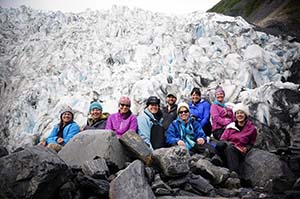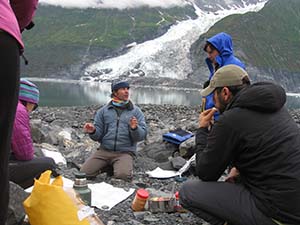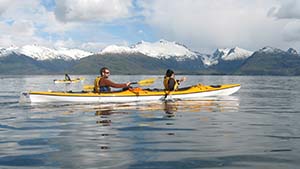By Elly Ray
Seward, Alaska

When the 1989 oil spill happened in Prince William Sound, I remember being horrified about it and doing my share of finger pointing. Yet, in no way did I even begin to understand the impact it had on Alaskans and their way of life. As a 28-year-old Pennsylvanian, it fit my notions of environmental degradation, and that’s where it stopped.
Appreciating Alaska for its lifestyle and pure beauty only began when I moved here in 2005. As I developed friendships and began exploring the great land with my children and my spouse, I began to understand the subsistence culture I had joined—but my understanding leapt this summer through an amazing experience I shared with several teachers in Prince William Sound. Now the oil spill creates in me a strong drive to be proactive about protecting this wonderful place we live.
Can we measure the passion Alaskan youth have for Alaska? Could they possibly be taking the beauty and way of life for granted? Can we trust them yet as we pass the torch of protecting our land and way of life to them? Their young lives have not been interrupted by a major earthquake, tsunami, or oil spill of the Exxon Valdez magnitude. While they partake in the lifestyle, do they have a deep understanding of its vulnerability?

This is where my July adventure in Prince William Sound ties it all together for me. Under the thoughtful guidance of Betsi Oliver, from Alaska Geographic, and Tim Lydon, of the USFS, six Alaskan teachers, one San Francisco teacher, and one UAF journalism student camped, kayaked, and studied together for one week in the Nellie Juan Wilderness Area of Prince William Sound. During that time, we shared amazing experiences.
We attended class led by Lydon while watching a seal spy on us from the shoreline, and a whistle pig get comfortably close to us on the boulders where we sat. We ate gourmet food prepared by Oliver, as we chatted about the Native Alaskans who slept on the same wilderness shores we visited, and the gold miners and explorers who called this their home many years ago. We joked that we’d traded in our computers and smartphones for glacier TV: “Ohhhhhhhhh! Did you see that one?” and “Wow that was a huge piece that fell off. Did you hear it crash?” We slept with the chill from the nearby glaciers, forcing us deeper into our mummy bags. We paddled through still waters that reflected the snow-capped mountains and floated for hours in our kayaks near several tidewater glaciers. We felt disgusted when we learned how there is still oil from the spill just under the surface on many beaches. I believe I can safely speak for all of us when I say that we came away with a determination to make a difference, having been changed forever by the closeness we felt with Alaska during our trip.

I’m an Alaskan elementary school teacher, and now I fully grasp my responsibility. To make a difference, I must provide experiences for my students that leads them to understand how it will be their job as they get older to protect our precious natural resources—the water, plants, and animals—and the lifestyle that so many Alaskans depend upon. I must ignite their passion so it burns as brightly as mine does now. My wish is that environmental degradation is not simply a catch phrase on my students’ lips. Instead, it needs to propel them into action to prevent ruin from ever touching our shores again.